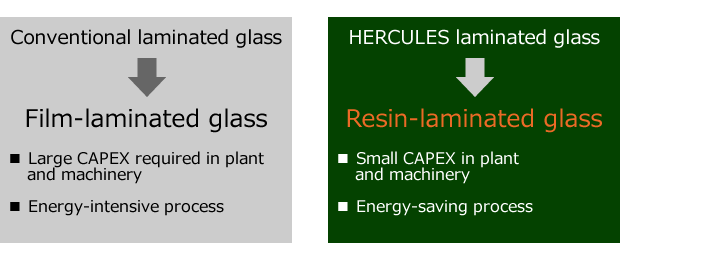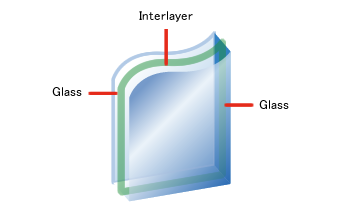Laminated Glass
Laminated glass consists of two or more panes of glass firmly bonded with plastic interlayer(s). Laminated glass provides the following advantages that have never been realized by monolithic tempered glass or insulated glass:
Major advantages of laminated glass are;
- Shatterproof in the event of breaking (safety)
- Preventing penetration against impact (security)
- Sound insulation
- Cutting UV rays by more than 99%
In addition to transparency that allows abundant daylight and expansive views, outstanding advantages of laminated glass over conventional glazing are increasingly attracting attention of architects around the world.
Manufacturing Technologies of laminated glass
There are two kinds of manufacturing technologies for laminated glass; "film lamination" and "resin lamination". Nowadays, almost all the laminated glass is made by film lamination.
In the film-lamination process, a film made of polyvinyl butyral (PVB) is placed between two layers of glass,
and chemically and mechanically bonded to the glass panes with high temperature and high pressure in an autoclave pressure vessel. The manufacturing line of the film-laminated glass requires a large amount of capital expenditure, and also consumes an enormous amount of energy for PVB film forming as well as the adhesion in an autoclave.
Production process of film-laminated glass
1, Film forming, an energy-intensive process : by chemical maker
2, Adhesion of film to glass layers with high temperature and high pressure, which consumes enormous amount of energy : by glass maker
HERCULES Resin-Laminated Glass
Hercules Glass Tech Co., Ltd. has focused on resin-laminated glass,
and succeeded in developing "HERCULES Resin-Laminated Glass" manufacturing technology, which features remarkable advantages over prevailing film-laminated glass.
Comparison of film-laminated glass and HERCULES resin-laminated glass

HERCULES resin-laminated glass is manufactured by injection of liquid resin (polyurethane/acrylic-resin specifically developed by Hercules for laminated glass) into the space between glass panes to form a transparent interlayer firmly bonded to glass in ambient temperature and under atmospheric pressure. The manufacturing process neither requires so large an investment in plant and machinery nor consumes a large amount of energy.
The manufacturing technology of HERCULES resin-laminated glass saves energy consumption, which helps prevent global warming. An autoclave process (high temperature and high pressure) in conventional production line consumes electricity as much as 2KW/m2,
while Hercules' resin-laminated glass manufacturing process eliminates any autoclaves, reducing carbon footprint as much as 0.72Kgs (2KW/m2 x 0.36Kg-CO2 = 0.72Kg/m2.)
Integration of Safety/Security and Energy Efficiency
Safety/Security is always paramount in building design. Laminated glass is an ideal solution for glazing on account of its outstanding safety/security performance over traditional tempered glass or IG glazing.
However, the energy loss associated with glazing is also a major concern for architects and owners alike. Overheating by glaring sun in summer and heat loss in freezing winter represent a major portion of air-conditioning load, and significantly affect operating cost of the building.
Hercules has thus developed HERCULES COOL 50TM and HERCULES COOL 30TM to mitigate the foregoing problem by significantly cutting infrared ray radiation.
Hercules’s resin-laminated glass integrating safety/security performance and the IR cutting function of COOL 50 (or COOL 30) offers ultimate solution for building glazing.


